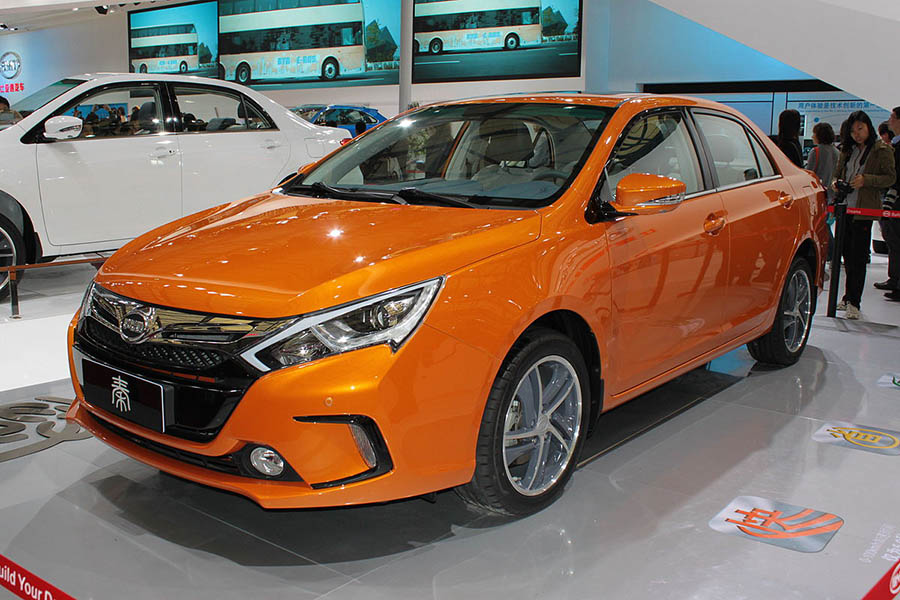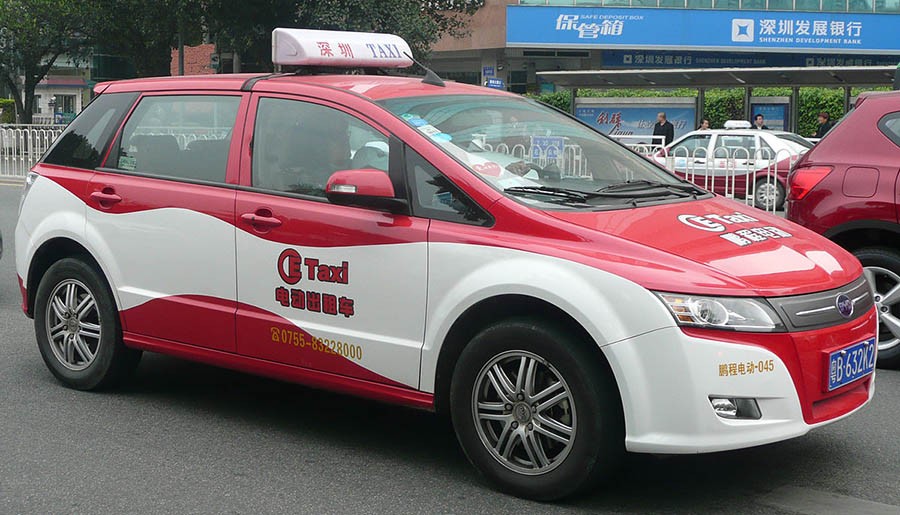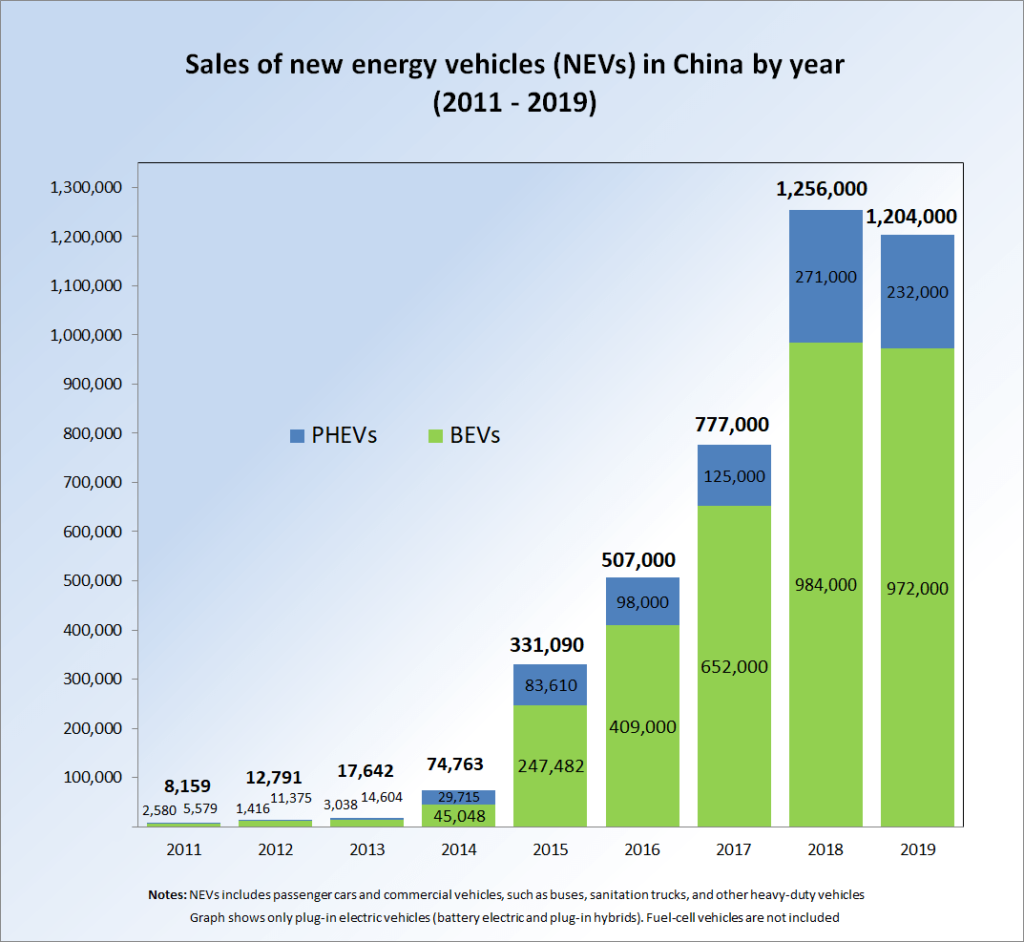The use of electric cars in China represents a growing industry in the country. In 2019 China was the largest producer of electric vehicles, with nearly 1.2 million units.

Industry
The Chinese government approved a plan in 2009 to leave behind current automotive technology and take advantage of the growing new vehicle market to be one of the world leaders in the manufacture of all- electric and hybrid vehicles. The government’s political support for the adoption of electric vehicles has four objectives: to create a world-leading industry that will produce jobs and exports; energy security to reduce its dependence on oil from the Middle East; Reduce urban air pollution and reduce carbon emissions.
In June 2012, the State Council of China published a new energy industry development plan for domestic energy-saving vehicles and the plan sets a sales target of 500,000 new energy vehicles in 2015 (5 million by 2020), as sales were much lower than initially expected and most of the population of new electric vehicles has been bought by the government for public fleets. New monetary incentives were issued in 2014 and the government national set a sales target of 160,000 units by 2014. Although the objective was not achieved, sales of new new energy vehicles in 2014 amounted to 74,763 units, 324% more than in 2013. The increase in demand continued in 2015, with a total of 331,092 electric vehicles sold in in 2015, the increase of 343% year-over-year. The China Association of Automobile Manufacturers (CAAM) expected sales of new energy vehicles to reach more than double by 2015 and 700,000 new in 2016.
Government incentives
The Chinese government uses the term new energy vehicles (NEVs) to designate plug-in vehicles, and only electric vehicles and hybrid electric vehicles are subject to incentive purchase. Initially, conventional hybrids were also included. On June 1, 2010, the Chinese government announced a trial program to provide incentives for new energy vehicles of up to 60,000 yuan (~ US $9,281 in June 2011) for the private purchase of new battery electric vehicles and 50,000 yuan (~ US $7,634 in June 2011) for plug-in hybrids in five cities. The government set a target to increase the country’s annual production capacity to 500,000 hybrid or all-electric cars and buses by the end of 2011, up from 2,100 in 2008. An announcement made in mid-September 2013 by the National Commission of Development and Reform, in conjunction with the ministries of finance, science, and industry confirmed that the central government will provide a maximum of $9,800 for the purchase of a fully electric passenger vehicle and up to $81,600 for an electric bus. The subsidies are part of the government’s efforts to tackle problematic air pollution in China.

In April 2016, the Traffic Management Bureau, under the Ministry of Public Security, announced the introduction of new green number plates to identify new energy vehicles, instead of the country’s standard blue plates. The purpose of the special license plates is to facilitate police control of the preferential policies that some local authorities apply to cleaner cars to help reduce emissions and ease traffic. For example, central Beijing has launched a road space rationing scheme, a regulation that prohibits driving conventional vehicles in the city for one day a week, but new energy vehicles are exempt from the restriction.
Sales
Sales of new energy vehicles totaled 502,572 units between January 2011 and March 2015, of which more than 92% were sold since January 2014, with 58,125 units sold during the first three months of 2016 (11.6 %), 331,092 units (65.9%) in 2015 and 74,763 (14.9%) in 2014. These figures include heavy industrial vehicles such as buses and sanitation trucks. The Chinese electric vehicle stock consists of 366,219 all-electric vehicles (72.9%) and 136,353 plug-in hybrids (27.1%). By December 2014, a total of 83,198 electric passenger cars were registered in the country since 2008. With 176,627 passenger cars sold in 2015, China outperformed the U.S., (The best-selling country in 2014, and became the country with the most sales market for plug-in hybrid cars in the world in 2015). By March 2016, as to the existence of low power electric vehicles, China is in second place after the United States, with cumulative sales of about 300,000 vehicles. By December 2015, plug-ins in China had accounted for 21% of global cumulative sales of legal passenger electric cars on the road.

The stock of new energy vehicles sold in China since 2011 surpassed the milestone of 500,000 units in March 2016, making the country the largest market for plug-ins in the world when all electric vehicle segments are considered. More than 160,000 new energy vehicles powerful have sold between 2011 and 2015, of which 123,710 (77.2%) were sold in 2015. The new energy vehicles in 2015 consisted 100,763 fully electric vehicles (81.5%) and 22,947 plug-in hybrid vehicles (18.5%). The share of all-electric bus sales in the Chinese bus market rose from 2% in 2010 to 9.9% in 2012 and is expected to close to 20% by 2013. As of December 2014, China had about 36,500 fully electric buses. By December 2015, China was the largest electric bus market in the world, and in 2020, the country expects to account for more than 50% of the global electric bus market.
A total of 8,159 new electric vehicles were sold in 2011, with passenger cars (61%) and buses (28%). Of these, 5,579 units were electric and 2,580 hybrids. The sale of electric vehicles represented 0.04% of the sale of new vehicles in 2011. The sale of new vehicles reached 12,791 units in 2012, which includes 11,375 electric vehicles and 1,416 hybrids. New energy vehicles represented 0.07% of the country’s total sales in 2012. During 2013, new energy vehicles reached sales of 17,642 units, up 37.9% since 2012 and representing 0.08% of nearly 22 million vehicles sold in 2013. Deliveries included 14,604 electric and 3,038 hybrids. The vehicle earned higher sales in a period between 2011 and 2013 was the Chery QQ3 EV city car, with 2,167 units sold in 2011, 3,129 in 2012 and 5,727 in 2013.
During 2014, sales of new energy vehicles reached 74,763 units, which consist of 45,048 all-electric vehicles and 29,715 plug-in hybrids. Of these, 71% were passengers, buses with 27% and 1% trucks. Electric vehicle sales increased 210% since 2013, while hybrid sales grew 880% over the previous year. The market share of the electricity segment reached 0.32% of the 23.5 million sales of new cars sold in 2014. BYD Qin was ranked as the best-selling electric vehicle in China in 2014, with 14,747 units sold during year 34 and became the best-selling passenger car in the country each time. The Qin was followed by the all-electric EV Kandi with 14,398, Zotye Zhidou E20 with 7,341 units, and the BAIC E150 EV with 5,234.
Sales of new energy vehicles in 2015 totaled 331,092 units, consisting of 247,482 all-electric vehicles and 83,610 hybrid vehicles, an increase of 449% and 191% from 2014, respectively. Sales of passenger vehicles, excluding imports, amounted to 176,627 units in 2015, allowing China to rank as the largest seller in the electric car market in 2015. The market share of the segment of Electric passenger cars rose to 0.84% in 2015, up from 0.25% in 2014. The top-selling model in 2015 was the BYD Qin Hybrid with 31,898 units sold, followed by BYD Tang with 18,375 units; In the fully electric were the Kandi EV with 16,736 units, BAIC E150 / 160/200 EV 16,488 units, and the Zotye Z100 EV with 15,467 units.
As of December 2015, with 31,898 units sold in 2015, BYD Qin continued as the best-selling passenger vehicle in the country, with cumulative sales of 46,787 units since its introduction. The BYD Qin was the second biggest selling in the world of hybrids in 2015 after the Mitsubishi Outlander PHEV, and also ranks fifth among major electric cars sold in the world in 2015. BYD Auto ended 2015 as the highest in sales of cars, with nearly 60,000 units sold, followed by the Tesla S, with 50,580 units sold in 2015.









